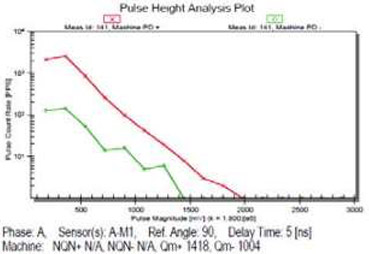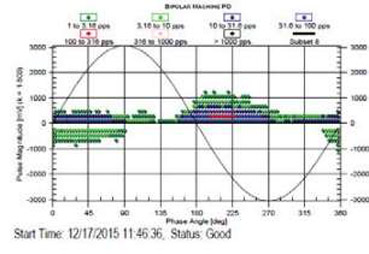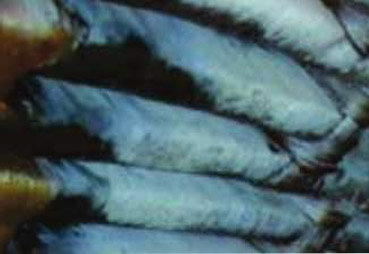Excerpt from”Fault Detection In Components Of Synchronous Motors Through Online Partial Discharge Measurements”, G. Castro, Petrobras
Company:
Petrobras, Brazil
Machine Description:
Synchronous Gas Compressor Motor, 3 MW, 13.8 kV, 4 salient poles, Manufactured in 2002
Failure Mechanism Identification Through Condition Based Monitoring:
Petrobras installed online Partial Discharge (PD) Monitoring in 2015 on the synchronous gas compressor given the importance and operational time of the machine in 2015. The motor was equipped with 80 pF epoxy mica capacitive couplers and the data was collected with a portable partial discharge analyzer.
The data collected was referenced against the manufacturer partial discharge severity tables to determine the relative severity of partial discharges against similar machines since there was no historic partial discharge data available for that machine to trend.
The synchronous gas compressor motor on presented partial discharge magnitudes on the three phases that were considered extremely high when compared to the manufacturers statistical database.
Figure 1: Pulse Height Analysis Plot Showing High Surface Partial Discharges

Figure 2: Pulse Phase Analysis Plot Showing High Surface Partial Discharges

Analysis of the partial discharge data on the synchronous gas compressor motor by the customer indicated a Qm of 1418 mV on Phase A, 1368 mV on Phase B and 1458 mV on Phase C. This is indicative of extremely high partial discharge activity in the surface of the insulation (positive Qm is predominant) and possibly in the semi conductive coating inside the slot.
Corrective Maintenance Prior to Machine Failure
The maintenance team recommended a scheduled outage of the machine. During the maintenance, an inspection of the stator winding identified signs of partial discharges.
Additionally, there was a large white area along many of the stator windings with a rough surface, which is typically indicative of a chemical attack due to corrosive strength of the nitric acid arising from ozone created with partial discharges. This is evident in Figure 3 below.
Figure 3 – Surface Damage on The Stator Winding Caused by Ozone Activity

Customer Outlook of Condition Based Monitoring
Petrobras continues to follow the philosophy of maintenance and inspections based on information obtained non-invasively.

